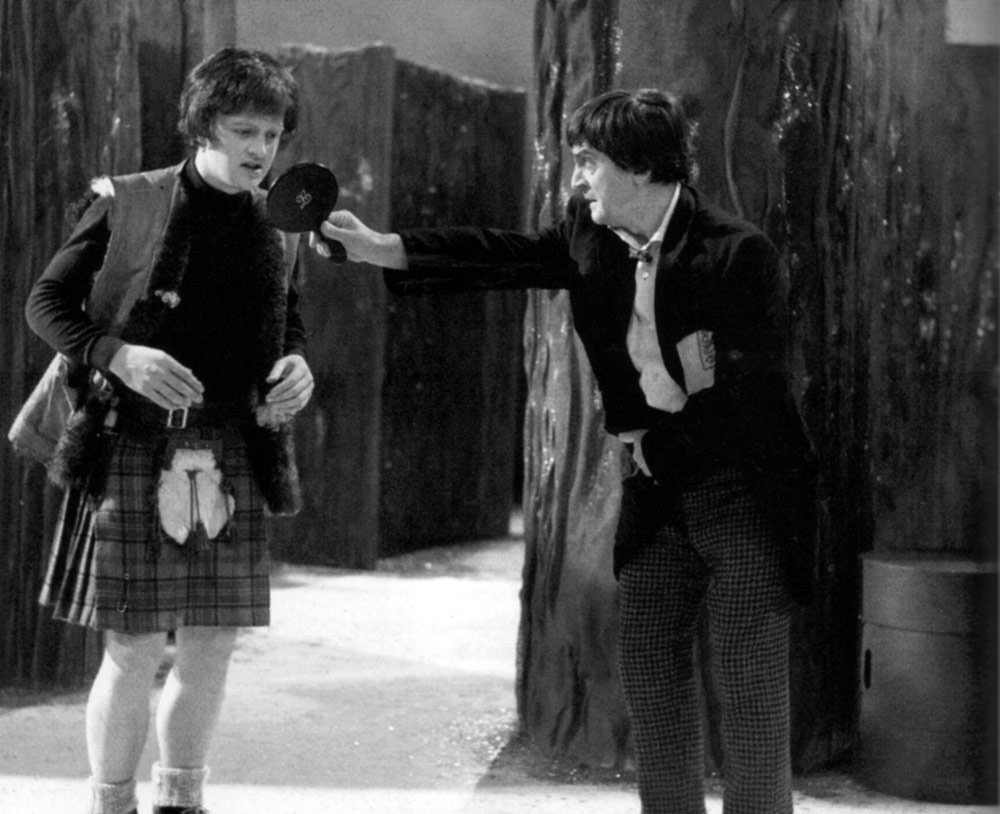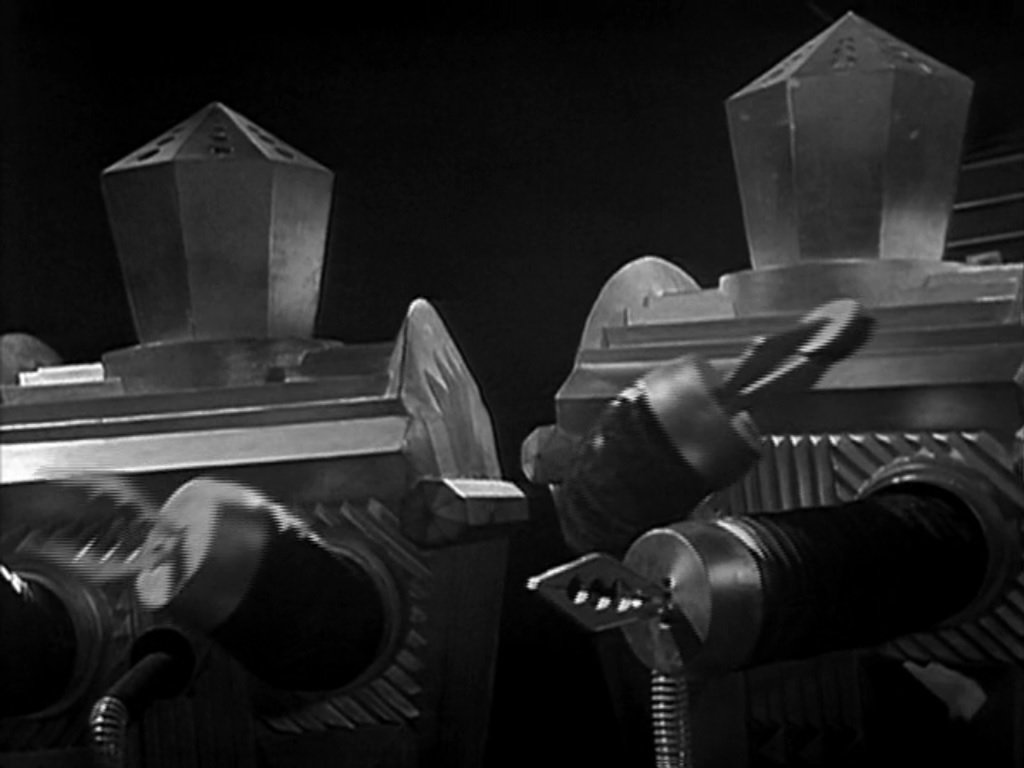Continuing the in-depth look at behind-the-scenes of Doctor Who‘s past, issue 8 of The Complete History focuses on three Second Doctor stories: The Mind Robber, The Invasion, and The Krotons.
I’m going to announce something controversial here: I’m not a fan of The Mind Robber… but I think The Krotons is brilliant. Discuss. No, wait, hang on. Let me explain my thinking.
First of all, The Mind Robber is something I should love. Admittedly, it’s full of imagination, it’s wonderfully different from anything else on TV, and has Wendy Padbury in a catsuit. These are all very positive things for the serial. Sadly, it’s a five-part story that should be three. Once we get past the surreal white spaces of Part One, the following Parts Two, Three, and Four should’ve been condensed into one.
I admire the ideas on display – especially the forest made of words – but we don’t really have to see fictional character after fictional character after fictional character to get what the whole thing’s about. Look, here’s A Man With A Big Nose! D’Artagnan! Rapunzel! Schoolchildren! Fiction should be exciting, but this re-treads the same ground.
It’s a relief when Emrys Jones crops up.
The Krotons, meanwhile, has a bad reputation. It’s no Caves of Androzani. But it’s not Kill the Moon either. Its reputation lies in the fact that it’s by Robert Holmes, who people expect better of, and because it was, for a long while, the only four-part Second Doctor story held by the BBC. True, it pales into comparison against Tomb of the Cybermen. People expect something genius from Holmes, when in that instance, he delivers just average Who.

And so this volume of The Complete History is going to be more “hit” than “miss” for most, with two of the three serials covered considered great, but it’s likely I’d have different serials in each column.
But once again, the book forces you to re-evaluate the stories. I still think The Mind Robber is far too long, but the work involved makes me want to watch it again. Hopefully, other readers will be similarly swayed to rewatch The Krotons and enjoy it for what it is, rather than pass it off and conclude that “hey, it’s by Robert Holmes, so it should be better.”
The photos used to illustrate The Mind Robber do it no favours either. It just looks a bit dull, especially followed by the glory of Cybermen walking down the steps by St. Paul’s Cathedral; even The Krotons boasts fun images of Patrick Troughton’s Second Doctor. Generally, the best are of the Doctor shielding himself from the twin suns under an umbrella. Page 109 in particular has an often-used but nonetheless fantastic photo of the Doctor, taking up a full page.
A similar shot follows on page 114, one that most (myself included) won’t have seen before. Then opposite, we have Madeleine Mills’ Vana giving her best “oh Rene” look to camera. This is a very fun instalment of The Complete History – but then, that’s the Second Doctor era to a tee.
The fun extends to the text too: Production details that could become a bit dry are livened up, for instance, by a recollection that two women, who had never seen Doctor Who before, were shocked to see Cybermen climbing out of the sewers – presumably, they figured it was a real invasion!
We even get an image of possibly my favourite Troughton scene: It’s in The Invasion, where the Doctor’s hopping about, dodging explosions. You know the one I mean. Then Isobel (Sally Faulkner) goes to take his photo, the Doctor mumbles something about the imminent Cybermen threat, then decides to fuss his hair and make sure he looks good for the camera! What a wonderful actor, and what a great serial.

Yep, we can debate about The Mind Robber and The Krotons (editor, John Ainsworth glosses over the latter entirely in his introduction to the volume), but the book’s on steadier ground with The Invasion. Because who doesn’t get a thrill from seeing the Cybermen marching around London, Kevin Stoney’s Tobias Vaughn grim realisation that he can’t control the metal monsters, and an insane Cyberman warbling along down a sewer? Some would no doubt argue it’s the quintessential Second Doctor story.
Its greatest sins are that: i) its final episode consists largely of missiles blowing stuff up (Doctor Who tends to find smarter ways of defeating the enemy); and ii) it eventually led to Dark Water/ Death in Heaven (2014), not that it’s really to blame for the latter. Otherwise, it’s a cracking tale.
Enjoyment is enhanced by a stunning colour photo of the Cybermen in front of the Cathedral, which can be found on page 89. Further still, we have behind-the-scenes images of the actors in the middle of donning their alien disguises, Patrick and Frazer Hines (Jamie McCrimmon) performing in front of the crew (and possibly fans too), and an explosion being triggered in front of a Cyberman.
I really didn’t realise the outfits worn by Wendy Padbury (Zoe) and Sally Faulkner were so bright, but we can see them in all their glory thanks to a couple of extra colour pictures.
These more than make up for the fact that this is the first volume released that unfortunately suffers from having no broadcast images available for two episodes. I had wondered how the partwork would deal with these missing episodes, but it fills the gaps well.
In the case of The Invasion, they could’ve used animated stills, but have elected not to. In fact, this is one of the disappointments with Volume 13: there are only two pictures taken from the animated DVD (these in the Merchandise section). It would’ve been nice to have had maybe an extra page dealing with the animation. Ah well. At least we have the DVD itself to enjoy.

There’s still plenty to learn about from this issue, and it seems a good time to note just a few titbits that interested me:
- The pony that doubled as a unicorn in The Mind Robber was called Goldy, and the crew had to use white blanco, borrowed from a nearby RAF base, to hide its true light brown colouring.
- The Three Musketeers‘ D’Artagnan was based on the real-life captain of the King’s musketeers in the 17th Century, Charles de Batz-Castelmore d’Artagnan.
- Frazer Hines made a bid for pop success during The Invasion, his not-quite-a-hit record, Who’s Dr. Who? being released in October 1968.
- Having been in the Army, director, Douglas Camfield was annoyed to learn that Colonel Lethbridge-Stewart had been promoted to Brigadier. “The most he could ever command in the series (because of money) was six men,” he rationalises. “As it was, a Colonel in the Infantry commands something like 900 men, and a Brigadier three times that number.”
- David Maloney, director, was disappointed by the actual Krotons – as was designer, Bobi Bartlett. Her initial designs can be seen on page 108, and they’re fantastic. Unfortunately, they were made to the wrong scale…
Maloney is the subject of one of this issue’s Profile pieces, while the remaining two are about Kevin Stoney, and Robert Holmes. Stoney only gets a couple of pages, while Maloney has double that.
Holmes, however, commands five pages, and that brief overview of his life might be the stand-out feature in this book. If it encourages people to find his full biography, Richard Molesworth’s Robert Holmes: A Life in Words, then that’s all the better.
NEXT: WARRIORS OF THE DEEP, THE AWAKENING, AND FRONTIOS.
Want to subscribe? Head over to the Doctor Who: The Complete History site – and don’t forget about the premium subscription offer too!
